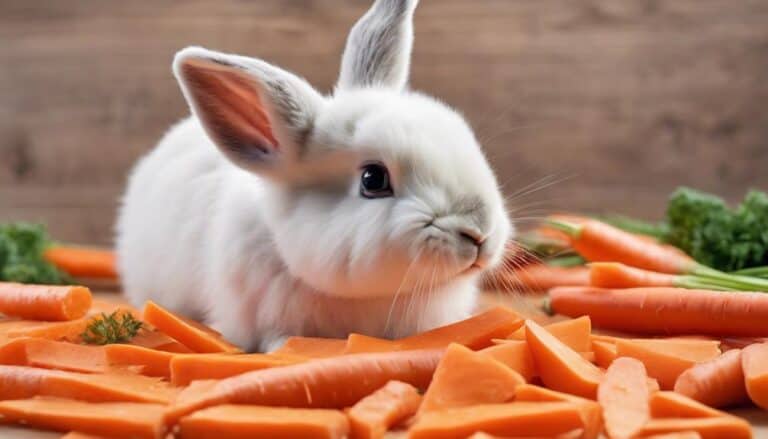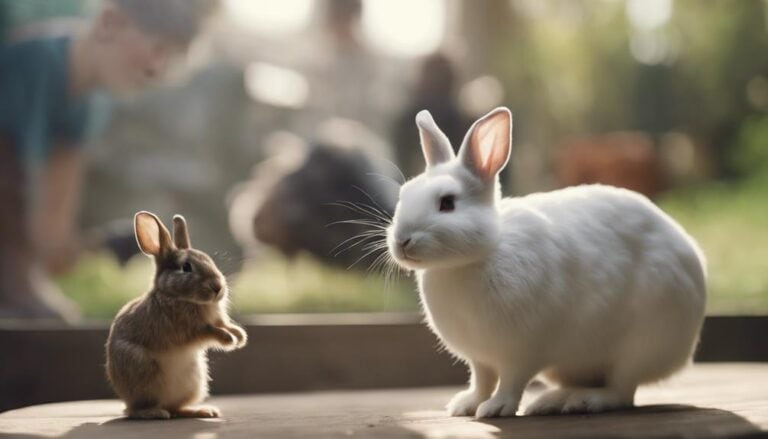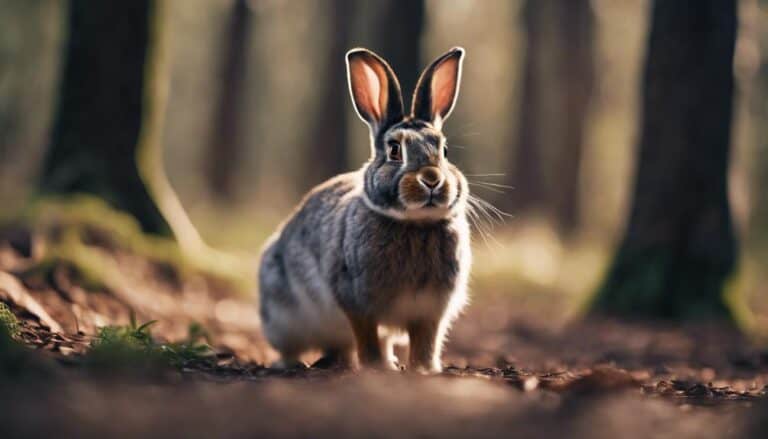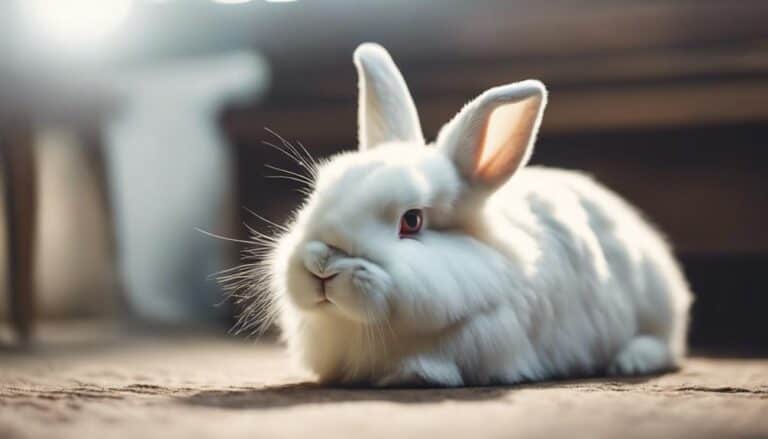Rabbits have over 600 muscles in their bodies, which is pretty impressive. These muscles let them do all sorts of things like hop, dig, and move around with ease. Rabbits are incredibly agile creatures, thanks to their strong muscles that provide them with remarkable flexibility and speed. In addition to their impressive muscle structure, rabbits and their vision capabilities play a crucial role in their ability to detect predators. Their large eyes allow them to see nearly 360 degrees around them, helping them stay alert in the wild.
But have you ever thought about how their muscles are structured or what makes them different from other animals?
Well, let's take a closer look at the rabbit's muscular system. It's actually pretty fascinating. For starters, rabbits have a unique combination of fast-twitch and slow-twitch muscles.
The fast-twitch muscles help them make quick movements, like when they sense predators and need to hop away fast. The slow-twitch muscles, on the other hand, are better for endurance activities like digging burrows.
One of the most interesting things about rabbit muscles is how they're designed for power and speed. Rabbits have very strong back legs, which they use to propel themselves forward.
In fact, their back legs are so powerful that they can generate forces of up to 10 times their body weight! That's like a human being able to jump the length of a football field.
Rabbits also have very flexible joints, which helps them move around easily. Their joints are designed to bend and flex in all sorts of ways, allowing them to twist and turn with agility.
This flexibility is especially important for rabbits, since they need to be able to squeeze through narrow holes and navigate tight spaces.
So there you have it – a brief look at the amazing muscles of rabbits. These little creatures are truly remarkable, and their muscular system is just one of the many things that make them so special.
Contents
- 1 Key Takeaways
- 2 Muscular System of Rabbits
- 3 Hindquarters Muscular Masses
- 4 Skeletal Muscles in Rabbits
- 5 Longissimus Dorsi Muscle
- 6 Tissue Heterogeneity in Muscles
- 7 Nerve Tissue in Skeletal Muscles
- 8 Blood Vessels in Muscles
- 9 Muscle Contraction Mechanisms
- 10 Muscle Relaxation Processes
- 11 Nutrient Supply to Muscles
- 12 Conclusion
Key Takeaways
Rabbits have a special kind of muscular system that helps them move around and do physical activities. This system is made up of two types of muscle fibers: fast-twitch and slow-twitch fibers. Each type of fiber has a different job to do.
The fast-twitch fibers are great for quick movements like hopping and running. That's why the hindquarters in rabbits are so important – they're the powerhouses behind these fast movements. On the other hand, the slow-twitch fibers are better suited for slower, more enduring activities.
One of the most important muscles in a rabbit's body is the Longissimus dorsi muscle. This muscle runs along the spine and helps with movement and stability. Without it, rabbits wouldn't be able to twist and turn like they do.
Muscles are essential for a rabbit's daily life. They need them to move around, eat, and even breathe. And because muscles need a lot of energy to function, they're rich in blood vessels that supply them with oxygen and nutrients.
Muscular System of Rabbits
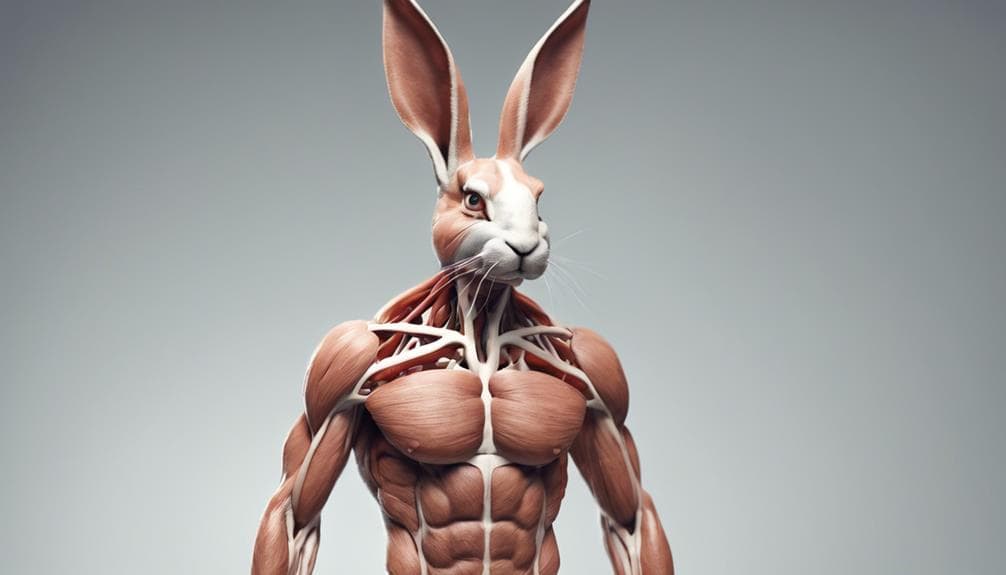
Rabbits have a specialized muscular system that helps them adapt to different physical demands.
For example, their skeletal muscles have a mix of fast-twitch fibers for quick reactions and slow-twitch fibers for sustained activities.
This combination allows them to respond swiftly to their environment and also endure prolonged exercises when needed.
The muscles in their hindlimbs have a high proportion of fast-twitch fibers, which are essential for swift movements and escape responses.
The skeletal muscles in rabbits are highly specialized, and one muscle in particular, the Longissimus dorsi muscle, is prominent when it comes to meat production.
These muscles come in a variety of shapes, sizes, and functions, which indicates a strong tissue heterogeneity that aids in different locomotor activities.
Interestingly, the skeletal muscles in rabbits continue to grow until they're around 5-7 months old.
During the first 5-6 weeks of life, their muscle growth rate is slightly slower than their overall body mass growth rate.
This continuous adaptation and development of their muscular system contribute to the agility and survival capabilities of these remarkable animals.
Hindquarters Muscular Masses
So, let's talk about the hindquarters of rabbits. These areas are packed with muscles that are crucial for their movement and overall physical abilities. Rabbits rely heavily on their hindquarters for activities like hopping, running, and digging. These muscles are super developed and specialized to provide the power and agility they need to survive in the wild.
When you break it down, there are three main muscular masses that work together to make all this possible.
The gluteal muscles are responsible for extending the hip joint, which is essential for hopping and jumping. The hamstring muscles aid in flexing the knee joint and extending the hip joint, which is necessary for powerful propulsion. And the quadriceps muscles assist in extending the knee joint, enabling rapid movements and maintaining posture.
These three muscular masses work together like a well-oiled machine to support the rabbit's hindquarters during various movements, allowing them to navigate their environment efficiently. They're key contributors to the rabbit's speed, agility, and ability to escape from predators. By understanding the importance of these muscles, we can appreciate just how remarkable the physical capabilities of rabbits really are.
Skeletal Muscles in Rabbits
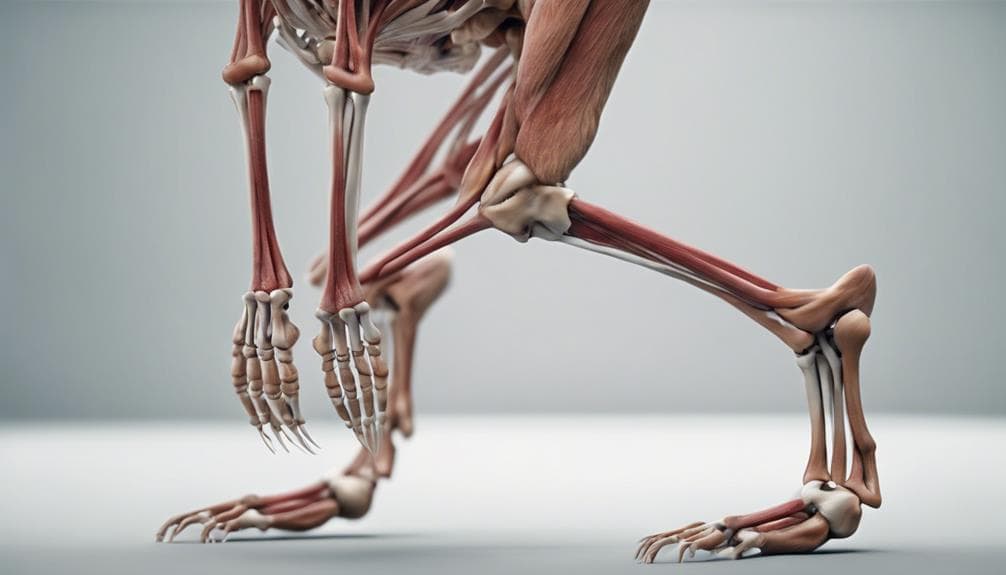
Rabbit skeletal muscles are really important for helping them move around. They're connected to the skeleton in lots of different places. These muscles come in all shapes and sizes, and they do different things.
One muscle in particular, called the Longissimus dorsi, is really important when it comes to how much meat you can get from a rabbit.
The muscles themselves are made up of lots of tiny fibers. These fibers take up a lot of space inside the muscle.
They're wrapped up in a special kind of tissue called endomysium that's rich in a protein called collagen. This special tissue helps make the muscle structure really intricate.
Rabbit Muscle Structure
Rabbits have a complex system of muscles that help them move around, and most of these muscles are found in their hindquarters. The muscles themselves are made up of lots of tiny fibers, which make up about 75-90% of the muscle. These fibers are the building blocks of skeletal muscle, and they're wrapped in a thin layer of tissue called endomysium that's rich in collagen.
These fibers are grouped together into bundles, which are then covered in another thin layer of tissue called perimysium. Scattered throughout these bundles are special cells called adipocytes, which store fat.
One of the most important muscles in a rabbit is the Longissimus dorsi, which is found in their back. This muscle is particularly significant because it's so big and meaty.
Muscle Function in Rabbits
Rabbits rely on their skeletal muscles to move around and perform daily activities. These muscles are connected to their bones through multiple attachment points, which allows them to hop, run, and even groom themselves.
The skeletal muscles in rabbits are made up of different types of muscle fibers. Some of these fibers, called fast-twitch fibers, are great for quick movements. Others, called slow-twitch fibers, are better suited for longer, more sustained activities. Each of these muscle fibers is covered in a layer of connective tissue called endomysium, which is rich in collagen and makes up a significant part of the muscle.
As rabbits grow, their skeletal muscles develop and get stronger. This growth is helped along by specialized cells called osteoblasts, which aid in bone growth and calcification. However, once rabbits reach a certain age – around 140-150 days – their muscles stop growing in length. This is because the epiphyseal plate, a area of cartilage that helps bones grow, closes.
Despite this, the skeletal muscles in rabbits continue to play a crucial role in their daily lives, allowing them to move around and function efficiently.
Muscular System in Rabbits
Rabbits have a complex muscular system that helps them move and keeps their skeleton strong. This system is made up of two types of muscle fibers: fast-twitch and slow-twitch fibers. Fast-twitch fibers are great for quick reactions, while slow-twitch fibers are better for longer, more sustained exercises.
The muscles in a rabbit's hindquarters, like their loins and thighs, are especially important because they help the rabbit move and connect to its skeleton. These muscles come in different shapes and sizes and do different jobs.
One of the biggest and most important muscles from a meat perspective is the Longissimus dorsi muscle.
Muscle fibers make up most of the muscle and are wrapped in a thin layer of tissue called endomysium. This tissue is rich in collagen, a type of protein.
When rabbits grow, their muscles develop alongside their bones. Special cells called osteoblasts help build bone tissue and make it stronger.
This growth usually stops when the rabbit is around 5-7 months old, depending on the breed.
Longissimus Dorsi Muscle
The Longissimus dorsi muscle is a pretty important part of a rabbit's body. Located along their spine, it plays a big role in their overall musculoskeletal system.
This muscle is long and paired, running parallel to the spine from the sacrum all the way up to the neck region. It's part of the epaxial muscle group, which is essential for moving and stabilizing the vertebral column.
In rabbits, the Longissimus dorsi muscle is responsible for actions like lateral flexion and extension of the spine. It's made up of both slow-twitch and fast-twitch muscle fibers, allowing rabbits to perform a range of movements with varying degrees of force and endurance.
One of the main reasons this muscle is so well-developed in rabbits is to support their hopping and running abilities. It helps them maintain posture, especially when they're moving around, and contributes to their agility and speed.
Understanding how the Longissimus dorsi muscle works is key to appreciating the intricate musculoskeletal system of rabbits.
Tissue Heterogeneity in Muscles
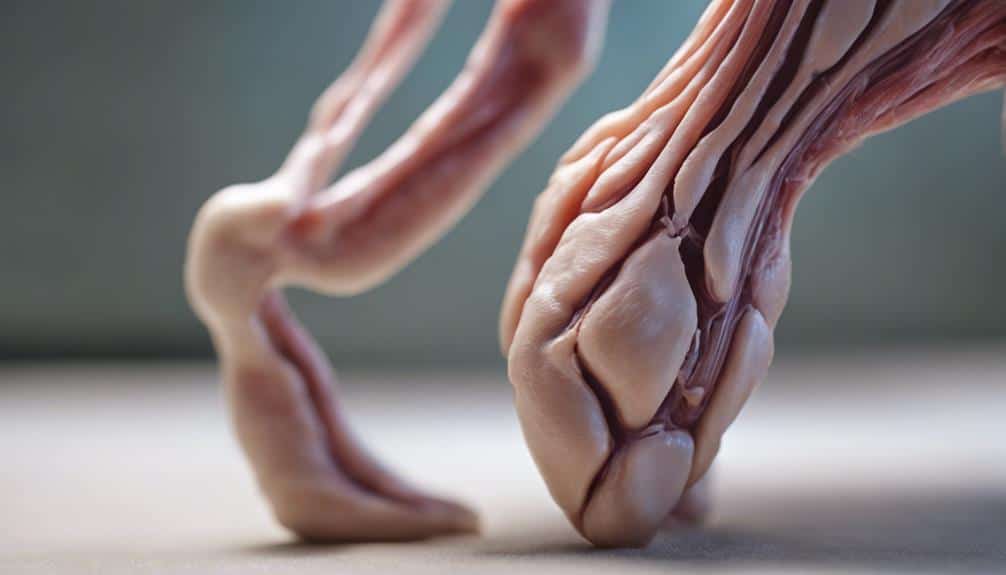
Rabbit muscles are made up of different types of fibers, which helps them adapt to different situations and survive in various environments. For instance, these fibers enable rabbits to quickly respond to threats and engage in activities that require sustained energy, like foraging and escaping predators.
So, what makes up these muscles? Well, rabbit skeletal muscles contain a mix of fast-twitch and slow-twitch muscle fibers. Each type of fiber has its own unique characteristics and functions.
The ability of these muscle fibers to change types based on exercise exposure is crucial for rabbits to adapt to changing environmental demands. For example, if a rabbit is consistently engaging in high-intensity exercise, its fast-twitch fibers will increase in number, allowing it to perform better in those types of activities.
The type of exercise rabbits engage in determines how their muscle fibers adapt, which in turn affects their performance in different activities. This is important because it means that rabbits can adjust their muscle composition to suit their specific needs.
Lastly, efficient energy production is essential for the function of both fast-twitch and slow-twitch muscle fibers in rabbits. This energy production primarily occurs through ATP and mitochondria, allowing the muscles to function properly.
Nerve Tissue in Skeletal Muscles
Within rabbit skeletal muscles, there are two types of fibers: afferent motor fibers and efferent sensitive fibers. These fibers play a crucial role in controlling muscle contraction and relaxation.
The nerve tissue itself is a vital component of skeletal muscles, allowing the nervous system to communicate with the muscles. This communication happens through specialized structures like motor endplates, where nerve fibers release neurotransmitters to trigger muscle contractions.
The point where motor neurons meet muscle fibers, known as the neuromuscular junction, is essential for transmitting signals that initiate muscle movements.
The nerve tissue in skeletal muscles ensures that the nervous system can effectively regulate muscle function. This allows for coordinated movement and motor control in rabbits.
Without this complex network of nerves within skeletal muscles, the ability to perform precise movements and respond to stimuli would be severely impaired.
In short, the proper functioning of nerve tissue in skeletal muscles is essential for the overall health and mobility of rabbits.
Blood Vessels in Muscles
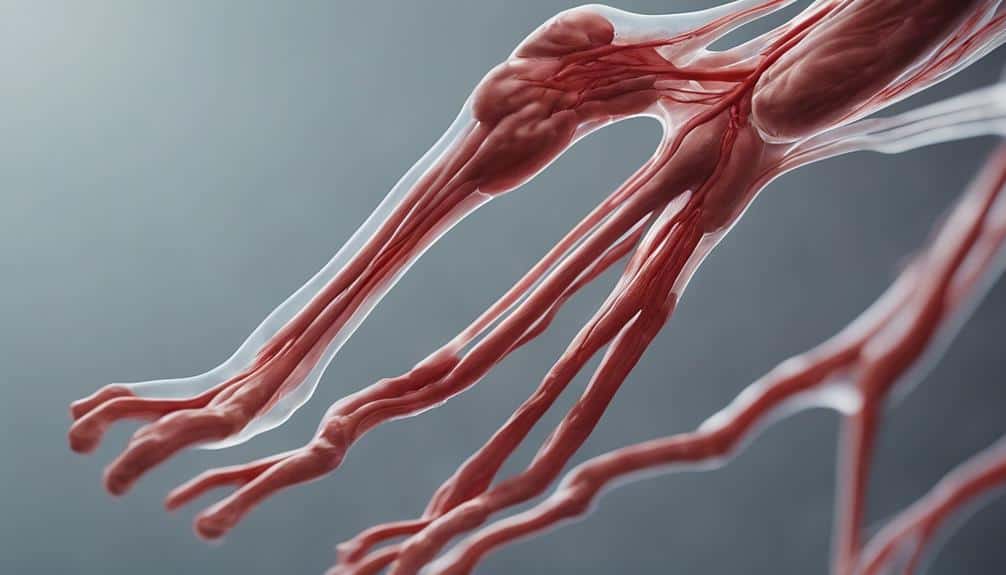
Blood vessels in muscles are really important for supplying muscle fibers with the nutrients and oxygen they need to function, while also getting rid of waste products.
So, how do they do this? Well, for starters, they make sure muscle fibers get a steady supply of nutrients and oxygen. This is crucial for muscles to work properly. They also help remove waste products that build up when muscles are active, such as carbon dioxide and lactic acid.
Interestingly, the number of blood vessels in muscles varies between species. For example, rabbits have a lot of blood vessels in their muscles. In rabbits, these vessels are surrounded by a special layer called endomysium, which is rich in collagen and provides support and protection.
The network of blood vessels in muscles, including tiny arteries and veins, is vital for keeping muscles healthy and functioning well. These vessels ensure that muscles get the resources they need to work efficiently and effectively. They not only support the way muscles contract and relax, but also contribute to overall muscle strength and endurance.
Muscle Contraction Mechanisms
Muscles contract through the sliding filament theory, where myosin heads bind to actin filaments to generate force. This process involves myosin heads interacting with actin filaments, forming cross-bridges that undergo a conformational change, which pulls the actin filaments towards the center of the sarcomere, resulting in muscle shortening and force generation.
The contraction process is controlled by calcium ions released when a nerve is stimulated. These ions allow myosin to bind to actin and initiate the power stroke. In rabbit skeletal muscles, particularly fast-twitch fibers, this rapid contraction is crucial for activities like escape responses.
The force generated during muscle contraction depends on several factors, including muscle length, contraction velocity, and motor unit recruitment.
The way muscle fibers are arranged, especially in pennate muscles, also affects the efficiency of force generation. By understanding these muscle contraction mechanisms, we can appreciate the remarkable capabilities of rabbit musculature.
Muscle Relaxation Processes
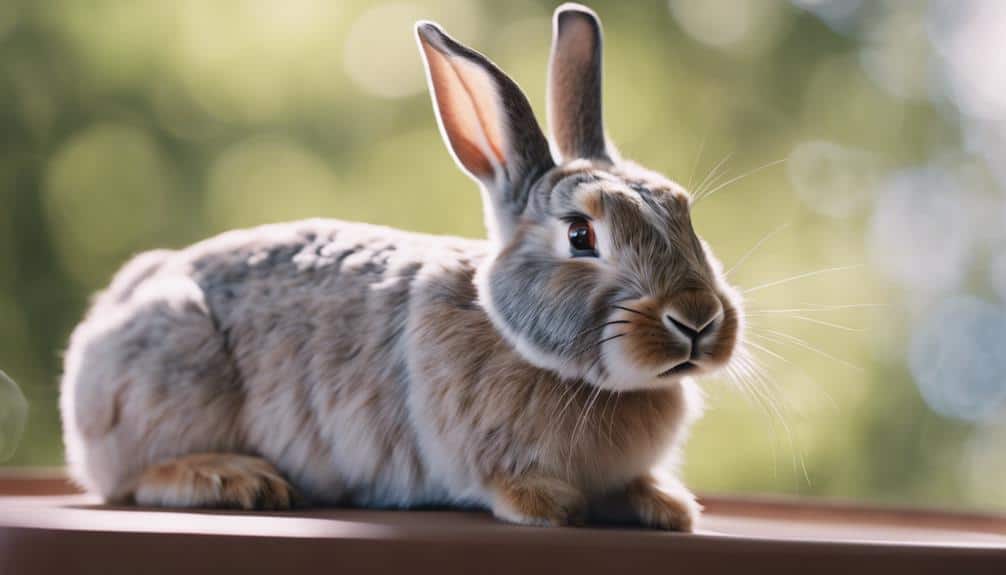
Muscle relaxation in rabbits is a complex process that involves several biochemical processes. These processes allow for efficient energy production and recovery after muscle contraction. Understanding how muscles relax is crucial for grasping the full spectrum of muscle function.
When a muscle contracts, calcium ions play a key role. After contraction, these calcium ions need to be pumped back into the sarcoplasmic reticulum to relax the muscle fibers. This process, called calcium ion pumping, requires ATP to fuel the active transport of calcium ions.
Another important process is the regulation of the troponin-tropomyosin complex. During relaxation, troponin and tropomyosin work together to block the myosin-binding sites on actin, preventing further muscle contractions. This ensures that the muscle doesn't contract again until it's supposed to.
Muscle relaxation also relies on ATP regeneration. ATP levels need to be replenished for ongoing muscle relaxation. This is achieved through processes like oxidative phosphorylation and glycolysis, which generate ATP to sustain muscle function.
Nutrient Supply to Muscles
To really understand how rabbit muscles work at their best, we need to look at how they get the nutrients they need. Muscles can't function without nutrients – they provide the energy and building blocks necessary for muscles to contract, relax, and perform overall.
In rabbits, like in other mammals, muscles get the nutrients they need through the bloodstream. The delivery of nutrients like glucose, amino acids, fatty acids, and oxygen is crucial for keeping muscles active.
When rabbits exercise or have periods of increased muscle activity, blood flow to their muscles increases, making sure they get a quick supply of nutrients and oxygen. This process is called muscle perfusion, and it's controlled by things like neural signals and local chemical mediators.
If muscles don't get the nutrients they need, they can't function properly and will get tired more easily during long periods of activity.
Conclusion
Rabbits do have muscles, and they're specially designed to meet their unique needs.
For instance, the Longissimus dorsi muscle is really important for meat production. This muscle shows just how diverse and specialized rabbit muscles can be.
What's interesting is that rabbits have a high proportion of fast-twitch fibers in their hindlimbs. This allows them to move quickly and respond to threats, which is essential for their survival.
Their muscular system is what enables rabbits to thrive in their natural habitats and adapt to different physical demands.

